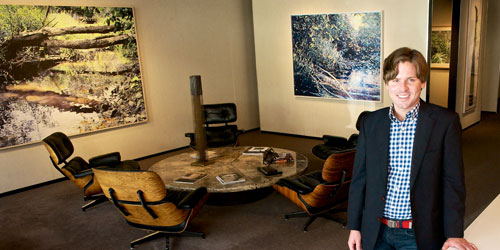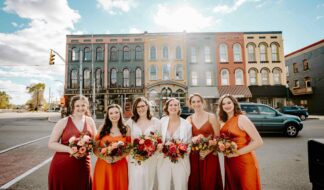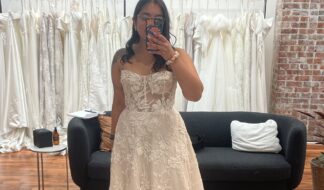
Thirty-six years ago, Robert Louis Kidd and Ray Frost Fleming opened a Birmingham landmark: the Robert Kidd Gallery. Partners in business and in life, the pair founded the establishment on Townsend Street in 1976, a popular place for home-art furnishings. Also, the oldest. The gallery is the longest running gallery in metro Detroit.
"They spent a fortune turning it into the most handsome gallery in the Midwest. They took pleasure in the gallery and making it blossom," says Ben Kiehl, 30, director of the gallery for the last four years. "It's a special spot with amazing timelessness."
Kidd and Fleming met at the internationally known Cranbrook Academy of Art in Bloomfield. They took their weaving skills and put them to good use by opening a yarn shop under the name Robert L. Kidd Associates. At the bottom of the stairwell they installed the Little White Gallery, where they showed tapestries from their weavings among other works created by Cranbrook students and local emerging artists.
As the gallery became more successful than the yarn shop, Kidd and Fleming redesigned the space adding new flooring, walls and furnishings in the 5,000-square-foot two-level gallery.
Kiehl remembers when Fleming used to tell people, "If you're on vacation and you see a gallery across the street from a hotel, it's a bad gallery. It's a boutique gallery." After the fancy Townsend Hotel ironically established its home across the street from the gallery in 1988, Fleming reminded people that he was there before the hotel, when it was a parking lot.
The well-maintained space has the same vintage character and charm as it did back in the '80s and 90s when the who's-who of the art world frequented the gallery. "They built it with quality in mind and the lasting potential. When they became a gallery, they would host black-tie invitation openings. It was elegant, cutting-edge and helped establish the reputation of the gallery," says Kiehl, adding that times have changed, but the gallery still has classy openings often in the form of cocktail parties complete with cheese and wine.
Outside of the gallery, Kidd and Fleming converted one of Marshall Fredericks' stables into a modern apartment. Yes, that Fredericks – the legendary artist who created the Spirit of Detroit. "They did the same thing when they bought a traditional farmhouse on Maple Road. It was a modernist home: beautiful, all custom. Bob was not afraid to spend money, even if he had to borrow it," recalls Kiehl.
While Kidd and Fleming were making their mark, Kiehl was earning his Fine Arts major at the Center for Creative Studies in Detroit. The budding photorealist painter was young but talented and began showing in exhibitions that happened to be sponsored by the Robert Kidd Gallery. "I stood out. I sold readily to different collectors from the area. The level of my work was above-average and was more sophisticated than student work at the time," says Kiehl, humbly. A professor of his suggested he visit the gallery to speak with Fleming, who noticed his work, which he didn't have a lot of at the time. Everything was a class assignment.
"Ray was a real character. Outgoing. Bob was shy. Ray really stood out and was very charismatic and charming. Originally from Georgia, he was independent, intelligent and very forward-thinking," says Kiehl.
Following his visit with Fleming, life took over and Kiehl worked toward finishing school, but sent an announcement to the gallery regarding his thesis exhibition. After the show, Kiehl received a call from Fleming's assistant director around graduation. "I thought he was calling about my work, but he asked a lot of questions to see if I wanted his job. Before the economy failed in 2005, people were more stable, whimsical and bohemian. Get a real job or be an artist? I decided I'm going to Europe for three months and I don't know when I'm coming back. He said if I'm still here when you come back, give me a call," remembers Kiehl. He returned that October, and took over in January.
"Ray thought I was a good fit. He talked about the way the art world works. Age doesn't matter. If they like your work, they will show it. I was able to get a foot in the door precociously," says Kiehl, who has been with the gallery for a total of seven years. "Ray and I were fast friends. We had tons in common. He was a kindred spirit. In a sense, he was like a surrogate father."
Kiehl remembers the signature red belt that Fleming wore. "His favorite combination was a bold striped shirt with flat front pants and bold silver or gray silk jacket."
Part of the legacy of the gallery and something that Kiehl absolutely agrees with is the composition and quality of work. "There is a sense of beauty in the way the work comes together. It's not about the subject matter. That's less important than the certain type of soul we look for when selecting work," he says.
And who you were wasn't an issue; it came down to the art. "Ray and Bob welcomed diverse designers and people. The only thing that mattered was the quality of the work." That hasn't changed. While exhibiting the work of many emerging contemporary artists, the gallery roster is further distinguished by such prominent names as Milton Avery, Harry Bertoia, John Chamberlain, Larry Rivers and Helen Frankenthaler. In addition, the gallery offers services for the acquisitioning and de-accessioning of artwork by significant modern and contemporary artists such as Deborah Butterfield, Hans Hofmann, Alexander Calder, Franz Kline and Richard Diebenkorn.
The only thing that will continue to change is the artwork, which rotates as exhibitions come and go. Some artists have been with the gallery for more than 20 years and some will show their work for the first time there.
"Ray often loved talking about paintings, explaining that the same person who loves realism can also love abstraction. It's all about balance, color and form. Fleming was not a detail man. That is the opposite of me. He saw the bigger picture, not dwelling on the incredible minutia of details. He opened me up conceptually."
Fleming passed away in April this year from breathing complications. Kidd preceded Fleming in death when he lost his battle with brain cancer five years ago.
"Having been so close to Ray, I miss him dearly," says Kiehl. "We were like family. Being at the gallery is a reminder of him. It's hard, but at the same time, I am so fortunate to have had so many years with Ray. I've learned so much. It's to my greater advantage. Being here keeps him more alive in my mind and there's an energy about it that hasn't disappeared."
For the last four to five years, Kiehl said Fleming called himself semi-retired. "He was behind the curtain handing me the baton whether or not I was aware of it. I was being groomed for the position. Legacy is important to Ray. I have been putting my own signatures in the gallery for the last few years as the gallery is an evolving entity. As the public evolves, so does the gallery and vice versa. My hope is to continue the gallery in keeping with the legacy while honoring the forward-thinking that made the gallery great in the first place."
Upcoming Exhibitions
Sweet Spot
An enticing contemporary group show featuring 10 to 15 artists from the local area and around the country.
Sept. 8-Oct. 20
Rick Vian
New works featured by the Royal Oak artist
Nov. 10-Dec. 15










